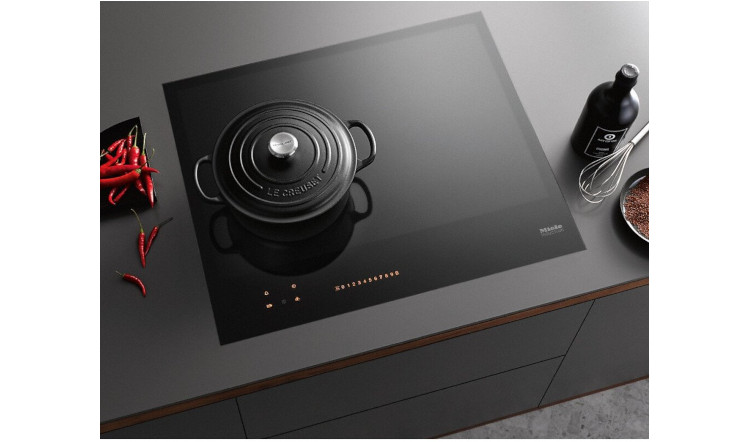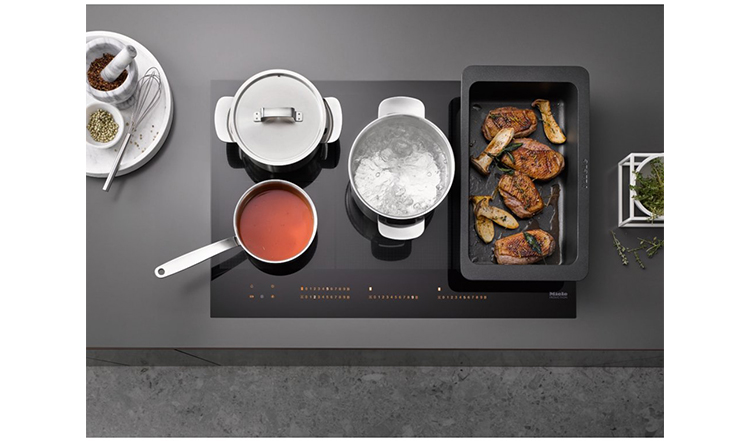What Is an Induction Hob and How Does One Work?
Category: Features
Have you ever used an induction hob, or been curious about how they work? Induction hobs are energy efficient, extremely safe and give excellent control over cooking temperature. If you’re thinking of replacing your hob in the near future, read on to learn more. We’ll cover:
- What is an induction hob?
- How does an induction hob work?
- Which pans can I use with an induction hob?
- Should I choose an induction hob?
What is an induction hob?
An induction hob is similar to an electric hob, with a couple of key differences. Induction hobs use less power and remain cold until they come into contact with a pan with a magnetic base. Coils underneath the surface of the hob create an electromagnetic field, which is activated by the pan to produce heat.
What does an induction hob look like?
An induction hob has a smooth black surface made from toughened ceramic glass, just like a ceramic electric hob. In fact, you usually can’t tell if a hob is an induction hob just by looking at it – it’s only when you use it you’ll notice the difference.

What is the difference between an induction hob and a ceramic hob?
When people talk about ceramic hobs they generally mean electric hobs with a ceramic glass surface. Induction hobs have this too, but heat up differently.
Induction hobs use high-frequency electromagnets to generate heat. By contrast, conventional electric hobs – sometimes called ceramic hobs – produce heat by passing an electric current through the coiled elements underneath the ceramic glass surface.
As well as producing heat in a different way to electric hobs, induction hobs are safer, faster to heat up, easier to control and use less power than other types of electric hob. They also have a sleek, modern appearance. What’s not to like?
Because of the way induction hobs work, it’s the pan that gets hot, not the hob itself. So not only are they safer to use than standard electric ceramic hobs, they’re also easier to clean, with no burnt-on food.
This type of hob also heats up more quickly than ceramic models, and gives you precise control over the cooking temperature. In fact, people who usually favour gas hobs because of how easily they can be turned up or down will find that induction hobs are just as convenient to cook with.
How does an induction hob work?
Induction hobs work by heating the pan rather than heating the hob. This means they’re incredibly safe to use, and easier to clean, with no burnt-on food. They heat up quickly and can be turned down quickly, too – so if you like cooking on gas hobs for that reason, think about an induction hob next time.
If you’re struggling to get your head round the science behind how they work, you’re not alone. To put it simply, induction means generating electricity using magnetism.
Underneath the surface of the glass is a coil of metal. When electricity passes through it, a magnetic field is created. When a pan with a magnetised base is placed on top, the circuit is completed, and the hob begins to heat up the pan directly. Apart from some residual heat from the pans, the hob itself remains cool.
Induction hobs also use a fan underneath the ceramic glass to cool the electrical components during cooking. This turns itself on and off as needed.
Here’s a look at the process step by step:
- When you turn on the power, a current flows through the coil of metal under the glass surface, generating a magnetic field around and above it.
- When you place a pan made from a ferrous metal (such as stainless steel or cast iron) on the hob, the magnetic field penetrates the metal of the pan.
- The electric current is now flowing through the pan too. As it swirls around inside the metal of the pan, the energy produced is turned into heat.
- The hot pan heats up the food or liquid inside it.

Which pans can I use with an induction hob?
Pans used on an induction hob must be made from a ferrous metal – one that contains iron particles, such as stainless steel or cast iron. Other materials, such as aluminium, copper, glass and ceramic will only work on an induction hob if they have a ferrous (also called ‘ferromagnetic’) base.
Confused about whether your current pans are suitable for an induction hob? Before you start looking into a new set of cookware, there’s a really simple way to check – just hold a magnet to the bottom of the pan. If it sticks, you’re good to go.
What happens if you use a normal pan on an induction hob?
Electricity only works if it forms a circuit, and a pan made from ferrous metal, or with a ferrous metal base, is needed to complete the circuit. Without the right pan, no circuit will be created and no heat will be generated. So if you use a normal pan on an induction hob it just won’t work. It’s as simple as that.

Should I choose an induction hob?
As you’d probably expect, induction hobs aren’t cheap – they’re the most expensive type of hob to buy and install. But they make up for that with incredible efficiency, both in terms of how quickly they cook and how little energy they use.
In fact, induction hobs are up to 50% more energy efficient than gas or electric ceramic models. Roughly 84% of energy from the electricity supply goes straight into the food you’re cooking. Compare that to a gas hob, where around 60% of heat energy literally disappears into thin air.
Need a little more help deciding whether to make the switch? We’ve put this section together to outline the advantages and disadvantages of cooking with induction hobs, starting with the good bits.
The benefits of induction hobs
Induction hobs have several key advantages over gas and conventional electric models, and efficiency has to be the main one. Induction hobs are efficient because very little energy is wasted – instead of heating an element and then transferring that heat to the pan, you simply heat the pan.
There are plenty more benefits too. Induction hobs are:
- Fast and responsive. They heat up and cool down quickly and offer precision temperature control: good news for anyone who’s serious about food and cooking, as well as those of us who are just in a hurry to eat.
- Energy efficient. Less energy wasted equals lower electricity bills.
- Safer to use. There’s no naked flame and no heated element to cause burns. When pans are removed, the hob stops heating up.
- Sleek and modern looking. With their minimalist look, they’ll fit right into your kitchen.
- Easier to clean. That flat, smooth surface means there’s nowhere for food and grime to hide. Plus the hob itself remains relatively cool to the touch, so spills and splatters won’t bake on to the surface.
- Great for helping you keep cool. All that heat energy is contained in the pan, making the home or professional kitchen a much more pleasant environment, especially in the summer months.
The disadvantages of induction hobs
So what are the disadvantages? We always like to warn people that, because induction hobs heat food more quickly than other methods, you might find yourself overcooking things at first. The pan won’t take as long to heat up, and will hold heat better than you’re used to.
We can’t think of many negatives, but here are some factors to bear in mind. Induction hobs:
- Can be a little too efficient. Expect an overcooked dinner or two until you get used to your superfast new hob.
- Often cost more than gas or electric. The technology is still relatively new, hence a higher price. But they’re becoming more affordable as more people make the switch.
- Need compatible pans. Most cookware is compatible with induction hobs, but older pans may not be. Check pans are marked ‘induction safe’ or check the bottom with a magnet.
- Can sometimes make a rattling or whirring sound. This is a result of the energy transferring from the coil to the pan.
- May scratch more easily. Manufacturers recommend using clean, flat-bottomed pans and avoiding sliding them on the surface of the hob, as well as avoiding sharp tools or abrasive cleaning products.
Is an induction hob right for me?
Even though induction hobs take a little getting used to, they offer some brilliant benefits for seasoned chefs and amateur cooks alike. They’re faster, adjust better to changes in temperature and cool down in no time at all. They’re incredibly energy efficient, delivering energy savings that go some way to compensate for the higher purchase cost. And they’re even safer than gas or electric – great if you’re often multitasking, or have children who love to help out in the kitchen.
However, ultimately the decision comes down to personal preference. Some people prefer gas hobs because they’re good for things like stir frying and searing steak. Or you might like the fact that ceramic hobs give you a high-end look for a budget-friendly price. And if you have a small kitchen, a space-saving domino hob could be the one for you.
Check out our kitchen hob buying guide for more tips on choosing your new hob.

Discover your new induction hob at Marks Electrical
We hope you’ve found this guide useful. If you like the sound of an induction take a look at our range today. and don’t forget we’re always on hand if you have any questions – just get in touch.
Tags
Latest Posts
Choosing The Best Oven For Baking




